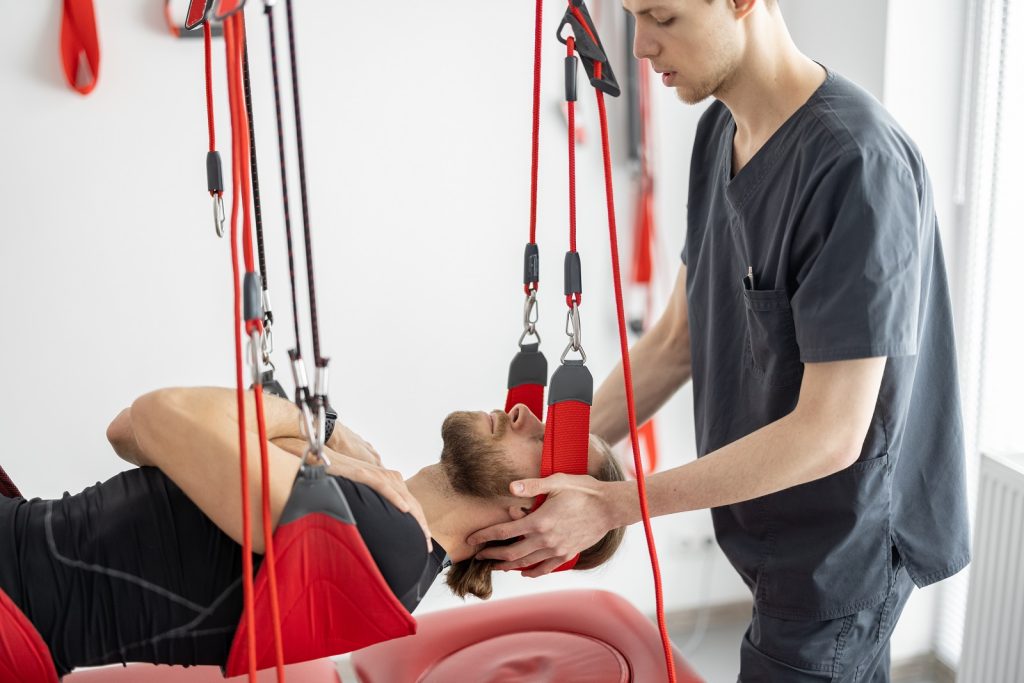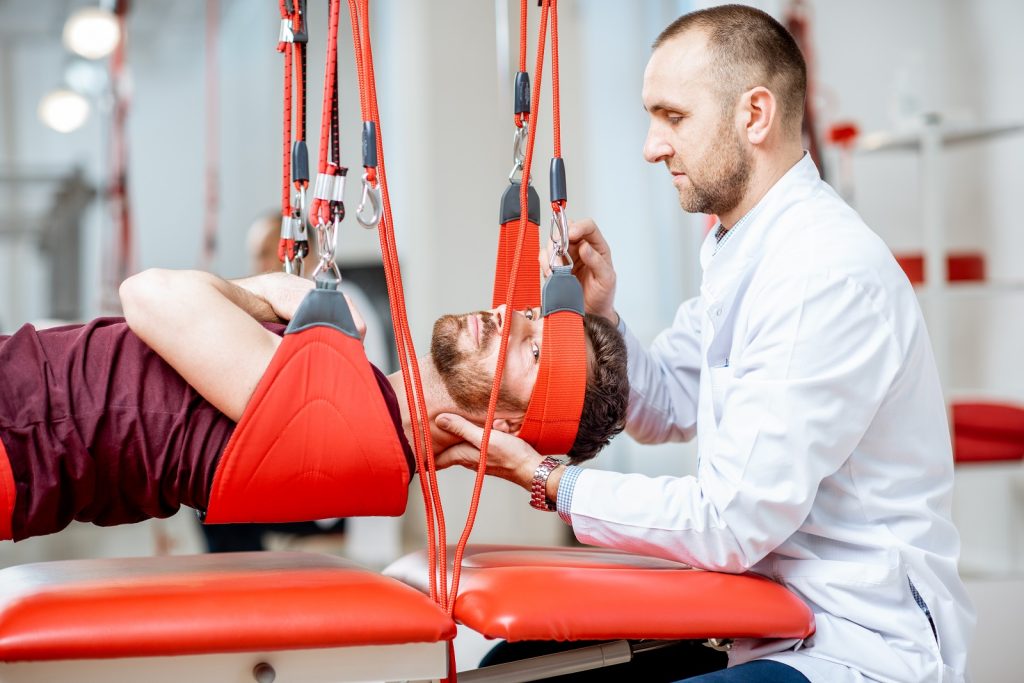Traction Therapy
Traction therapy is a non-invasive treatment method used to relieve pain, improve spinal alignment, and enhance overall spinal health. By applying controlled force to stretch and mobilize the spine, traction therapy can effectively treat a variety of conditions related to the spine and its associated structures. Here’s an in-depth look at what traction therapy involves, its benefits, and how it can help you achieve better spinal health.
What is Traction Therapy?
Traction therapy involves the application of a pulling force to stretch the spine, which helps to separate the vertebrae and relieve pressure on the spinal discs and nerves. This technique can be performed using manual methods, mechanical devices, or a combination of both. The goal is to create a negative pressure within the disc space, allowing herniated or bulging discs to retract, reducing nerve compression, and promoting the flow of healing fluids to the affected area.

Types of Traction Therapy
- Manual Traction:
- Description: A therapist uses their hands to apply force and gently stretch the spine.
- Application: Typically used for cervical (neck) traction but can also be applied to the lumbar (lower back) region.
- Benefits: Allows for personalized adjustments based on the patient’s response and comfort level.
- Mechanical Traction:
- Description: Utilizes specialized equipment to apply a controlled, consistent force to the spine.
- Application: Can be used for both cervical and lumbar regions.
- Benefits: Provides precise control over the amount and direction of force, which can be adjusted to suit the patient’s needs.
- Positional Traction:
- Description: Involves positioning the body in specific ways to use gravity to stretch the spine.
- Application: Often used at home as part of a self-care routine.
- Benefits: Simple and non-invasive, can be done without special equipment.
- Inversion Therapy:
- Description: The patient is positioned on an inversion table that tilts to use gravity to stretch the spine.
- Application: Typically used for lumbar traction.
- Benefits: Can relieve pressure on the spinal discs and improve overall spinal alignment.
Benefits of Traction Therapy
- Pain Relief: Traction therapy is highly effective in relieving pain caused by herniated discs, sciatica, and other spinal conditions. By reducing pressure on the nerves, it alleviates pain and discomfort.
- Improved Spinal Alignment: By gently stretching the spine, traction therapy helps to correct misalignments and improve posture. This can prevent future injuries and reduce chronic pain.
- Enhanced Mobility: Reducing pressure on the spinal discs and nerves can improve mobility and flexibility. Patients often find it easier to move and perform daily activities without pain.
- Promotes Healing: The negative pressure created during traction therapy encourages the flow of nutrients, oxygen, and other healing fluids to the affected areas. This can accelerate the healing process for damaged discs and other spinal structures.
Conditions Treated with Traction Therapy
Traction therapy is beneficial for a wide range of spinal conditions, offering relief and promoting healing through the application of controlled mechanical force. Here are some of the key conditions treated with traction therapy:
Herniated or Bulging Discs:
- Explanation: When the soft, gel-like center of a spinal disc pushes through a tear in its outer layer, it can compress nearby nerves, causing pain, numbness, or weakness.
- Benefits of Traction Therapy: Traction therapy helps to retract herniated or bulging discs, relieving pressure on the affected nerves. This decompression reduces pain and allows the discs to heal more effectively.
Degenerative Disc Disease:
- Explanation: This condition involves the gradual deterioration of the spinal discs, which can lead to chronic pain and reduced mobility.
- Benefits of Traction Therapy: Traction therapy reduces pressure on the degenerating discs, alleviating pain and discomfort. By creating space between the vertebrae, it promotes the flow of nutrients and oxygen to the discs, supporting their health and function.
Sciatica
- Explanation: Sciatica is characterized by pain that radiates along the sciatic nerve, which runs from the lower back through the hips and down each leg. It is often caused by nerve compression due to a herniated disc or spinal stenosis.
- Benefits of Traction Therapy: Traction therapy relieves pressure on the sciatic nerve, reducing pain, inflammation, and associated symptoms. This can improve mobility and quality of life for individuals suffering from sciatica.
Spinal Stenosis:
- Explanation: Spinal stenosis occurs when the spaces within the spine narrow, putting pressure on the spinal cord and nerves. This can lead to pain, numbness, and muscle weakness.
- Benefits of Traction Therapy: By widening the spinal canal, traction therapy reduces nerve compression and alleviates the symptoms of spinal stenosis. It helps restore normal nerve function and reduces pain and discomfort.
Facet Joint Dysfunction:
- Explanation: Facet joints are small stabilizing joints located between and behind adjacent vertebrae. Dysfunction in these joints can cause pain and limit movement.
- Benefits of Traction Therapy: Traction therapy improves mobility and reduces pain in the facet joints by decreasing pressure and promoting proper alignment. This helps enhance overall spinal flexibility and function.
Spondylolisthesis
- Explanation: This condition occurs when one of the vertebrae slips out of place onto the vertebra below it, potentially leading to nerve compression and instability.
- Benefits of Traction Therapy: Traction therapy helps realign the spine and reduce nerve irritation associated with spondylolisthesis. By stabilizing the vertebrae, it alleviates pain and prevents further slippage.
What to Expect During Traction Therapy
During a traction therapy session, you can expect the following steps:
- Initial Assessment: Your healthcare provider will assess your condition, discuss your symptoms, and determine the most appropriate type of traction therapy for you.
- Preparation: You will be positioned comfortably on a table or device designed for traction therapy. For mechanical traction, straps or harnesses may be used to secure you in place.
- Application: The therapist or device will apply a controlled force to stretch your spine. This force can be adjusted based on your comfort and response.
- Duration: Sessions typically last between 15 to 30 minutes. The exact duration will depend on your condition and the type of traction being used.
- Post-Therapy Care: After the session, you may be given exercises or stretches to perform at home to enhance the effects of the therapy.

Is Traction Therapy Right for You?
Traction therapy can be an effective treatment for many individuals with spinal conditions. However, it may not be suitable for everyone. Contraindications include:
- Acute Injuries: Traction therapy may not be recommended for individuals with recent fractures, sprains, or strains.
- Osteoporosis: Those with severe osteoporosis may be at risk of fractures during traction therapy.
- Spinal Infections or Tumors: Traction therapy is not suitable for individuals with spinal infections or tumors.
Traction therapy offers a non-invasive, effective solution for relieving pain, improving spinal alignment, and enhancing overall spinal health. Whether you are dealing with a herniated disc, sciatica, or another spinal condition, traction therapy can help you achieve relief and improve your quality of life.
Contact Us
Feel free to contact Dr. Burhan to book a consultation and learn how traction therapy can benefit your spinal health. Dr. Burhan and his experienced team provide personalized care and advanced treatment techniques to help you achieve optimal spinal function and well-being. Reach out today to take the first step towards a healthier, pain-free life.


